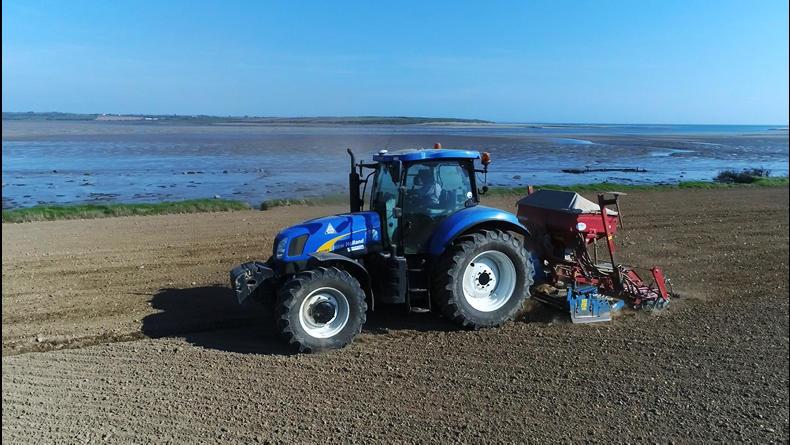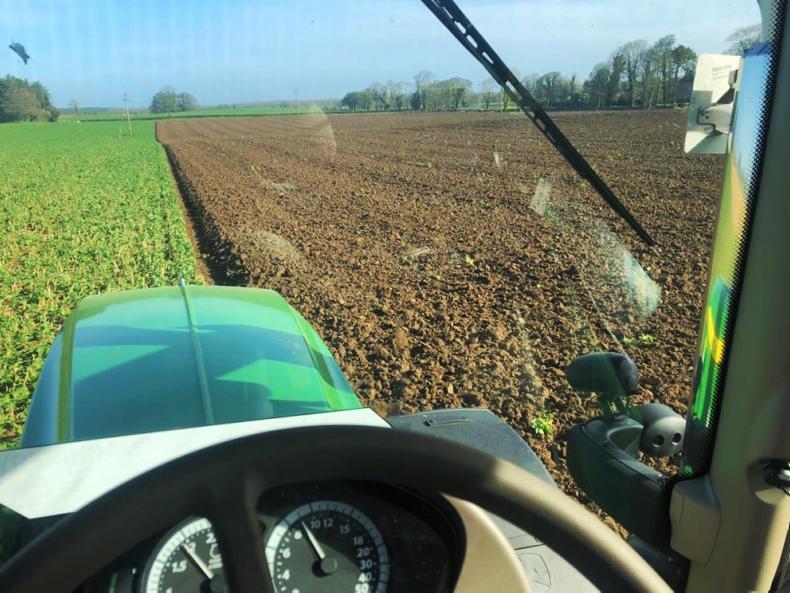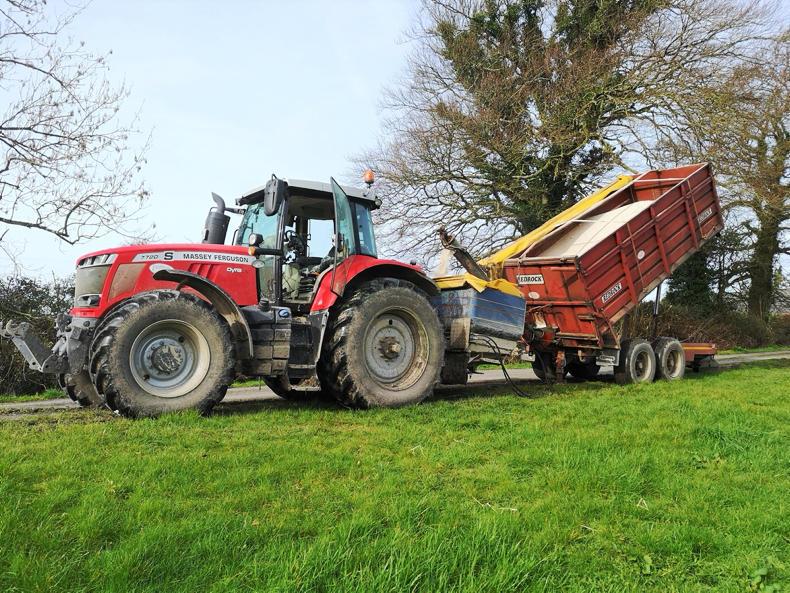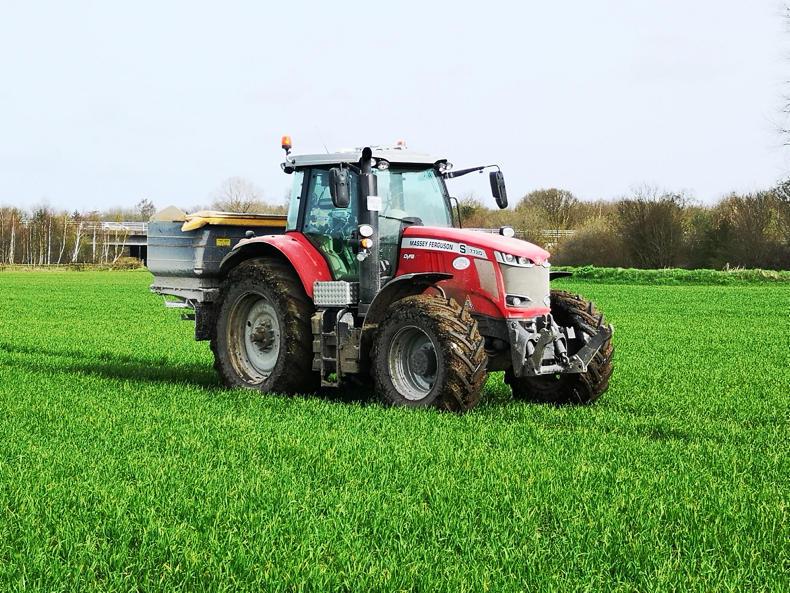
New Ross, Co Wexford
Sea fog and mist dominated the weather on Vivion’s farm last week, but the return of good weather has allowed field work to progress once again. Most of the field operations are now up to date and he has just started to sow spring barley in the past few days. All of the ploughing for spring cereals was completed in January in excellent conditions. Ground is now in good shape for sowing with his Accord drill.
Winter crops are in good condition. This year he’s growing Cassia and Quadra winter feed barley, as well as Craft winter malting barley. He’s also growing Costello winter wheat and Husky winter oats. Vivion spread between 300kg/ha and 490kg/ha of 10:8:25 on all of his winter barley and wheat crops around five weeks ago, while his oats received around 490kg/ha of 10:5:25. Last week his winter barley and wheat received between 180kg/ha and 370kg N/ha (27.6 %N + 4% S) to bring the crops up to 140kg N/ha. He doesn’t envisage that the winter malting barley nitrogen strategy will significantly differ to that of the feed barley. He also applied 185kg/ha of CAN on his oats to bring the crop up to 112kg N/ha.

Last autumn he incorporated an application of 0:10:20 in the seedbed when sowing his winter barley and wheat for the first time and he was very pleased with how they responded. Vivi0n began spraying his T1 fungicide applications last week. All of the crops received a combination of either a fungicide, growth regulator, herbicide or trace element.
His Craft winter malting barley received Proline (0.5l/ha), Jenton (1.0l/ha), CCC (1.0l/ha), Axial (0.15l/ha), Adigor (1.9L/ha) and Mantrax (1.0l/ha). His winter feed barley received Coyote (0.8l/ha) instead of Proline. The winter wheat received Alister (1.0l/ha) and Cameo Max (30g/ha) with Bio power (1.0l/ha).
His Husky winter oats received Diamond (1.25l/ha), Cameo Max (30g/ha), CCC (1.250l/ha) Manganese (1.5l/ha) and Lector (1.0l/ha).
In relation to the loss of Chlorothalonil last week, Vivion said: “Bravo is essential to us so what’s the alternative? Anything that is of any benefit to the tillage sector is being taken off the market.”

Eyrecourt, Co Galway
Rainfall over the past month had made ground conditions in Galway sticky but good weather this week has allowed field work to recommence. Chris has been busy ploughing this week and aims to be sowing by the weekend. The majority of his winter crops received 370kg/ha of 10:5:25 + S in February, as ground conditions were good and crops were forward.
He’s growing Cassia and Infinity winter barley this year and so far his Cassia appears to be performing better. His crops received 50kg/ha of GEN nitrogen (38% N + 7% S) mid-February. The GEN nitrogen is a slow-release protected urea, which he is trying out for the first year.
He’s also growing JB Diego winter wheat which has so far received around 40 kg N/ha. Most of his wheat is in after fodder beet and was quite lush looking earlier in the year. None of his winter barley was dressed with Redigo Deter and it has yet to receive an aphicide. All of his crops will be brought up to 150kg N/ha by 1 April. He intends to spray his T1 consisting of Proline, Jenton, Axial, Adigor, K2 and Sonis this week.

Last year, Chris ran both a plough-based and min-till system. Most of the ground was ploughed with a five-furrow Kevernland plough with no.8 boards, ploughing 18in. He sows them with a 3m mounted Lemken Sapphire box drill with front-mounted press. For the crops which were min-tilled, he first shallow-cultivated the ground with a Lemkin Ruben disc harrow and created a stale seedbed. He then cultivated at 4-5in, before drilling with his one-pass. There’s little visible difference in crop performance between establishment systems this year.
“The loss of Chlorothalonil is another kick to the entire Irish farming industry. We now can’t use a tool which is widely used on the grain that is imported into Ireland, and no one’s going to question it,” Chris said.

Ballybrittas, Co Laois
Ground has seeped well in Laois, after the weather settled down last week. “The drought last summer really opened the ground and has allowed our heavy land to soak quickly,” Paul explains.
His Bazooka, Carnival, Tower and Infinity winter barley and Grafton, Costello and Bennington winter wheat are all looking healthy. Crops are now at a normal growth stage for the time of year, after a cold March.
This week Paul is applying 320kg/ha N/ha (27% N) on his winter barley. He uses a Bogballe-mounted spreader with GPS section control on 24-metre tramlines.
On February 18, he spread 250kg/ha of 16:2.5:17 + S across his winter barley, followed by another 250kg/ha of 16:2.5:17 + S 10 days later. His winter wheat received 500kg/ha of the same compound last week. It was later than he would have preferred but ground just became trafficable last week.
Most of the crops received a pre-emerge herbicide of Navigate (0.3l/ha) and Stride (0.1l/ha) in autumn but headlands with sterile brome present also got Vigon (0.5l/ha) immediately after sowing.
In mid-February, a small amount of his winter wheat, which didn’t get a pre-emerge, received Alister flex (1.0l/ha) and Pixxaro (0.5l/ha).
At the end of the month the crops received K2 (1.0l/ha) and Wolf Trax manganese spray (150g/ha).

Drop the breakcrop
Paul has dropped spring beans from the rotation this year after a poor performance in 2018. Even in a good yielding year, the crop doesn’t stack up for him. Traditionally, he runs a continuous cereal enterprise and maintains take-all is only an issue with a break crop in the rotation. Paul, like many growers expressed his frustration about Friday’s decision on the withdrawal of approval for Chlorothalonil.
“Monday’s decision is another loss to our locker of chemistry and it’s going to affect Irish growers a lot more than some of our European friends. Where’s it going to end? And there doesn’t seem to be any restrictions on imported grain. It doesn’t seem to matter what they’re treated with,” he said.







 This is a subscriber-only article
This is a subscriber-only article










SHARING OPTIONS: